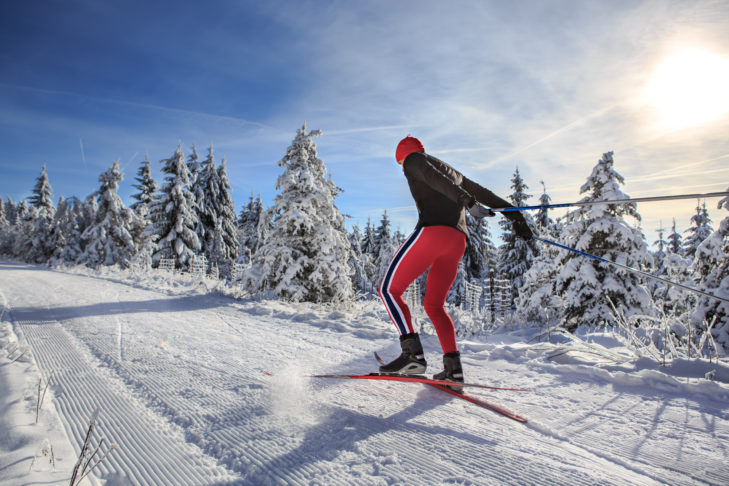Cross-country skiing is one of the oldest winter sports. And still today it fascinates the masses. Cross-country skiing and biathlon competitions are popular winter sports spectacles for spectators who are present live in the stadium, but also for those in front of the television screen. There is a good reason for this: the Nordic sportsmen and women compete in exciting races. There are many different disciplines in cross-country skiing and biathlon, which differ mainly in the distances. There are individual races and team competitions, which are run as relay or in a team. Men always run longer distances than women. In cross-country skiing, a basic distinction is made between short distances of up to 1.5 km and endurance distances of more than 5 km. This results in the following cross-country disciplines:
Short distances
These races are held over a short sprint distance of up to 1.5 km. Here, the athletes run against time alone or in a team. The team sprint is the team competition in the sprint. Two runners compete per nation. They run three rounds alternately. The Team Sprint has been an Olympic cross-country discipline since 2006.
Women
- 1.5 km sprint
- Team sprint: two runners á three rounds
Men
- 1.5 km sprint
- Team sprint: two runners á three rounds
Endurance distances
The longer endurance distances are in contrast to the fast races over shorter distances. There are also individual and team competitions in these cross-country disciplines. The following distances are distinguished.
Women
- 7.5 km classic + 7.5 km freestyle/skating (double pursuit)
- 10 km classic (interval start)
- 15 km classic or free style/skating
- 30 km classic (mass start)
- Four 5 km relays
Men
- 15 km classic + 15 km freestyle/skating (double pursuit)
- 15 km classic (interval start)
- 30 km classic or free style/skating
- 50 km classic (mass start)
- Four 10 km relays
Pursuit race
The pursuit race is usually the most exciting for the spectator to follow. These races follow the sprint, the results of the previous competition determine the starting order. The distances are 10 km for women and 12.5 km for men.
Mass start
The individual races over long distances of 30 km (women) and 50 km (men) begin with a mass start. The main feature of the mass start is that all runners start at the same time. This makes the race an event that attracts a lot of attention.
Skiathlon or double pursuit
At the Skiathlon the runners can prove how versatile they are. Both classic cross-country skiing and skating technique are in demand. Since the runners compete against each other individually and change technique in the middle of the course, this cross-country discipline is also called “double pursuit”. The single races are divided into two tracks. Men first ski 15 km in classic style, then change skis in a changing zone and then cover another 15 km in skating/free style. For women the distance is 7.5 km. This race also starts with a mass start. The winner is the runner who finishes first.
Cross-country skiing at the Olympics
Cross-country skiing has been an integral part of the Winter Olympics since 1924 – but only for men. Women have been competing in Olympic cross-country since 1952.
Biathlon
The disciplines and distances in biathlon are very similar to those in cross-country skiing, but here, besides running, shooting is also required. In the individual races there are sprints, pursuits and mass starts. In addition, there are the relays, in which mixed relays are added in addition to the men’s and women’s relays. With the exception of the single mixed relay, all biathlon disciplines are held at World Championships and Olympic Games.
Pursuit race
The most exciting races in biathlon are the pursuit races, in which the athletes compete not against the clock but against each other. Five laps are run (women 10 km, men 12.5 km), during which the biathletes have to shoot four times: lying twice and standing twice. The penalty for a mistake is a penalty round. The first to cross the finish line wins.
Relay race
There are separate and mixed relay races for women and men. In the normal relay there are four athletes per team. The women run 6 km, the men 7.5 km. Each competitor shoots once lying and once standing. In the transition zone, one runner hands over to the next through any form of body contact. In the relay, every runner has three reloading cartridges if he misses a target while shooting. A penalty round only has to be run if a target is not hit after using the reload cartridges.
In the mixed relay two women and two men per team start and cover 6 km twice and 7.5 km twice. Again, each team member has to shoot lying down once and standing up once.
Biathlon World Championships and Olympics
World Championships and World Cup series are held in biathlon. Since 1960 the biathlon (in that year with the 20 km run) officially belongs to the Olympic program. The first Biathlon World Cup was organized in 1978 and official World Championships have been held since 1958.
Travel tips for cross-country skiers and biathletes
In many ski regions, cross-country skiing centres offer beginners’ courses and well-maintained cross-country ski trail networks for advanced skiers. SnowTrex has put together the top destinations for cross-country skiers.






